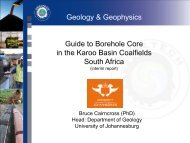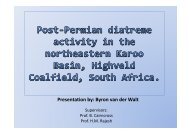coaltech upper olifants river catchment wetland inventory ...
coaltech upper olifants river catchment wetland inventory ...
coaltech upper olifants river catchment wetland inventory ...
Create successful ePaper yourself
Turn your PDF publications into a flip-book with our unique Google optimized e-Paper software.
3.6.6 Industries<br />
Industries can have a large impact on <strong>wetland</strong>s. The impacts differ between industries, but<br />
some impacts are common to all, e.g. polluted water. In addition, bad practices during the<br />
construction or operational phase can have far reaching impacts on <strong>wetland</strong>s in the vicinity<br />
or downstream of the industries. It is therefore imperative that sustainable development<br />
takes place and that industries adhere to strict control measures to limit the impacts of the<br />
development on the environment (Adebayo no date, Dugan 2005).<br />
3.6.7 Harvesting of <strong>wetland</strong> resources<br />
Wetlands are a source of various useful products, including fish, medicinal plants, plants<br />
used for crafts and building sand. The removal of these products is seldom controlled and<br />
this has led to the degradation of some of the <strong>wetland</strong> systems. Wetlands are an important<br />
source of building sand and the mining of these <strong>wetland</strong>s for sand has been extensive in the<br />
past. It has often happened that the sand is removed and the <strong>wetland</strong> is not rehabilitated<br />
afterwards. This degradation of the natural habitat favours the establishment of pioneer, and<br />
alien and invasive species (Palmer et al 2002, Kotze et al 2005).<br />
3.6.8 Infrastructure<br />
The network of roads and railways, with associated infrastructure such as bridges and<br />
culverts, in the <strong>catchment</strong> is well developed. The structures have a significant impact on the<br />
surface drainage patterns. Wetlands downstream of the roads and railways are drying up,<br />
and new <strong>wetland</strong>s are forming upstream of the structures. A common feature of road and<br />
railway crossings are that they restrict water flow, thereby causing backflooding upstream<br />
and concentrated flow downstream of the bridges. The result of this is erosion downstream<br />
of the bridges, often with extensive erosion gullies, and associated channel incision. This<br />
reduces the amount and frequency of overtopping occurring during a flood event. Several<br />
<strong>wetland</strong>s that are historically seasonally wet have therefore dried out to temporary wetness.<br />
The structures also interfere with the normal migration patterns of a number of animals,<br />
including frogs (Palmer et al 2002, Lizamore pers com 2004).<br />
Wetland Database for UORC - 50 -




